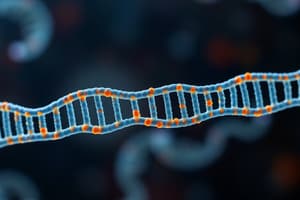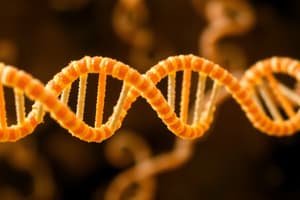Podcast
Questions and Answers
What is the purpose of telomere FISH probes?
What is the purpose of telomere FISH probes?
- To study RNA
- To study DNA
- To bind specifically to telomere regions (correct)
- To determine birth defects
What is a characteristic of multiple color FISH probes?
What is a characteristic of multiple color FISH probes?
- They use only radioactive probes
- They use only fluorescent probes
- They can utilize either fluorescent or radioactive probes (correct)
- They are used only for karyotyping
What is the main difference between FISH and Southern blotting?
What is the main difference between FISH and Southern blotting?
- FISH is used to study RNA, while Southern blotting is used to study DNA
- FISH is used for karyotyping, while Southern blotting is used for DNA profiling
- FISH uses radioactive probes, while Southern blotting uses fluorescent probes
- FISH uses fluorescent probes, while Southern blotting uses radioactive probes (correct)
What is the function of telomeres?
What is the function of telomeres?
What is the advantage of using FISH probes?
What is the advantage of using FISH probes?
What is the difference between karyotyping and FISH?
What is the difference between karyotyping and FISH?
What type of FISH probe is used to detect birth defects?
What type of FISH probe is used to detect birth defects?
What is the purpose of Whole chromosome FISH probes?
What is the purpose of Whole chromosome FISH probes?
What is a characteristic of FISH?
What is a characteristic of FISH?
What is the relationship between FISH and Southern blotting?
What is the relationship between FISH and Southern blotting?
Flashcards are hidden until you start studying
Study Notes
RNA Structure and Function
- RNA is typically single-stranded, unlike DNA, which is double-stranded.
- RNA uses uracil (U) instead of thymine (T) as a base to pair with adenine (A).
- RNA is usually single-stranded and contains the base uracil.
Transcription
- RNA polymerase is crucial for initiating transcription, the process of copying DNA into RNA.
- The terminator sequence marks the end of the transcribed region.
- RNA synthesis during transcription proceeds in the 5' to 3' direction.
RNA Splicing
- The spliceosome is a large protein complex that recognizes splice sites (intronic sequences) and facilitates intron removal and exon joining during RNA splicing.
- Alternative splicing allows a single pre-mRNA to be processed into different mature mRNAs by including or excluding different exons, increasing protein diversity.
Gene Expression and Regulation
- WT1 is a well-known tumor suppressor gene frequently mutated in Wilms' tumor, a childhood kidney cancer.
- Silent mutations are mutations that don't affect the amino acid sequence.
RNA Isolation
- Cell lysis is the initial step in RNA isolation, breaking open cells to release cellular contents, including RNA.
- Guanidium thiocyanate disrupts cell membranes and helps in protein denaturation during RNA isolation, allowing for better RNA extraction.
FISH (Fluorescence In Situ Hybridization)
- FISH uses fluorescent probes to target specific DNA or RNA sequences within a cell.
- FISH probes bind to their complementary sequences on the chromosomes, allowing researchers to visualize their location in the nucleus.
- Split gene probes are designed to bind to two separate regions within the same gene, used to detect breakpoints in the gene, which might be associated with genetic disorders.
- Telomere FISH probes bind specifically to the end regions of chromosomes, allowing researchers to study telomere.
- Multiple color FISH probes can be used to determine birth defects.
FISH vs. Southern Blotting
- Both FISH and Southern blotting can utilize either fluorescent or radioactive probes depending on the researcher's preference and the specific application.
- FISH is used to study DNA or RNA within a cell, while Southern blotting is used to study DNA or RNA outside of a cell.
FISH vs. Karyotyping
- FISH is used to study individual chromosomes or specific DNA sequences, while karyotyping is used to study the entire genome.
Studying That Suits You
Use AI to generate personalized quizzes and flashcards to suit your learning preferences.




